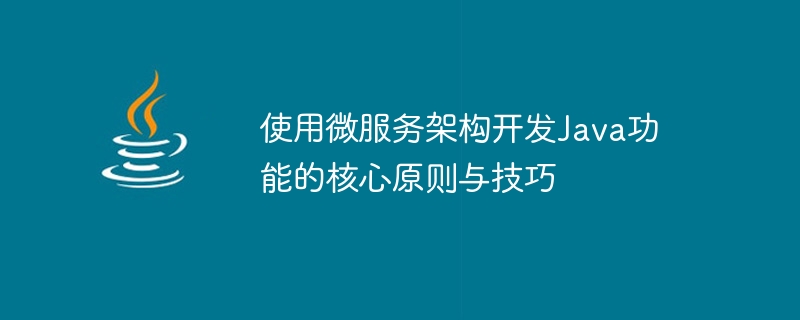

Core principles and techniques for developing Java functions using microservice architecture
With the rapid development of cloud computing and big data, traditional single applications are no longer suitable Complex business requirements. Microservices Architecture emerged at the historic moment and became an emerging paradigm for building scalable, flexible and maintainable applications. In this article, we will explore the core principles and techniques of using microservices architecture to develop Java functions and give specific code examples.
In the microservice architecture, each microservice should only focus on a single business function, rather than multiple functions. gather. This principle requires that the code of each microservice should be highly cohesive, focus only on its own business functions, and minimize dependence on other microservices. This can ensure the independence between microservices and improve the scalability of the system.
Sample code:
// UserService.java
public class UserService {
public void createUser(User user) {
// 省略创建用户的逻辑
}
public User getUserById(String userId) {
// 省略获取用户信息的逻辑
return user;
}
}
// OrderService.java
public class OrderService {
public void createOrder(Order order) {
// 省略创建订单的逻辑
}
public Order getOrderById(String orderId) {
// 省略获取订单信息的逻辑
return order;
}
}Each microservice should have autonomy, that is, it can operate independently Deploy, scale and upgrade. In order to achieve this goal, we can use some technical means, such as using Docker container deployment, using Kubernetes for automated container orchestration and management, and using the service discovery mechanism to achieve decoupling between services.
Sample code:
@FeignClient("user-service")
public interface UserService {
@PostMapping("/users")
User createUser(@RequestBody User user);
@GetMapping("/users/{userId}")
User getUserById(@PathVariable("userId") String userId);
}
@FeignClient("order-service")
public interface OrderService {
@PostMapping("/orders")
Order createOrder(@RequestBody Order order);
@GetMapping("/orders/{orderId}")
Order getOrderById(@PathVariable("orderId") String orderId);
}In the microservice architecture, the communication mechanism between each microservice requires It is asynchronous, which can improve the scalability and response speed of the system under high concurrency conditions. We can use message queues or event-driven methods to implement asynchronous communication between microservices.
Sample code:
// UserCreatedEvent.java
public class UserCreatedEvent {
private String userId;
// 省略其他属性及getter和setter方法
}
// OrderCreatedListener.java
@Component
public class OrderCreatedListener {
@Autowired
private UserService userService;
@KafkaListener(topics = "order-created")
public void onOrderCreated(OrderCreatedEvent event) {
User user = userService.getUserById(event.getUserId());
// 处理订单创建事件
}
}In a distributed system, network failures will inevitably occur. Problems such as service unavailability. In order to ensure the stability of the system, we need to implement fault tolerance and recovery mechanisms, such as using circuit breakers to handle service failures, using fallback strategies to provide alternatives, and using retry mechanisms to handle incidents. sexual mistakes.
Sample code:
@FeignClient(name = "user-service", fallback = UserServiceFallback.class)
public interface UserService {
// 省略方法定义
}
@Component
public class UserServiceFallback implements UserService {
@Override
public User createUser(User user) {
// 提供备选方案,例如返回默认用户对象
}
@Override
public User getUserById(String userId) {
// 提供备选方案,例如返回缓存中的用户对象
}
}Summary:
This article introduces the core principles and techniques of using microservice architecture to develop Java functions, including the single responsibility principle, service autonomy principle, asynchronous Communication principles and fault tolerance and recovery principles, and corresponding code examples are given. By following these principles and techniques, we can build microservice applications that are scalable, reliable, and flexible. Of course, there are many other concepts and technologies in microservice architecture that deserve in-depth discussion. I hope this article can provide readers with some ideas and inspiration.
The above is the detailed content of Core principles and techniques for developing Java functions using microservice architecture. For more information, please follow other related articles on the PHP Chinese website!




